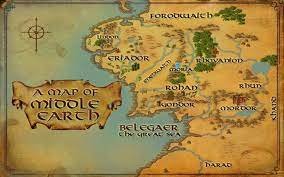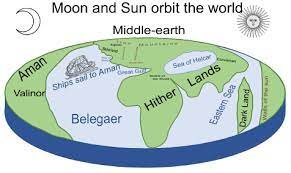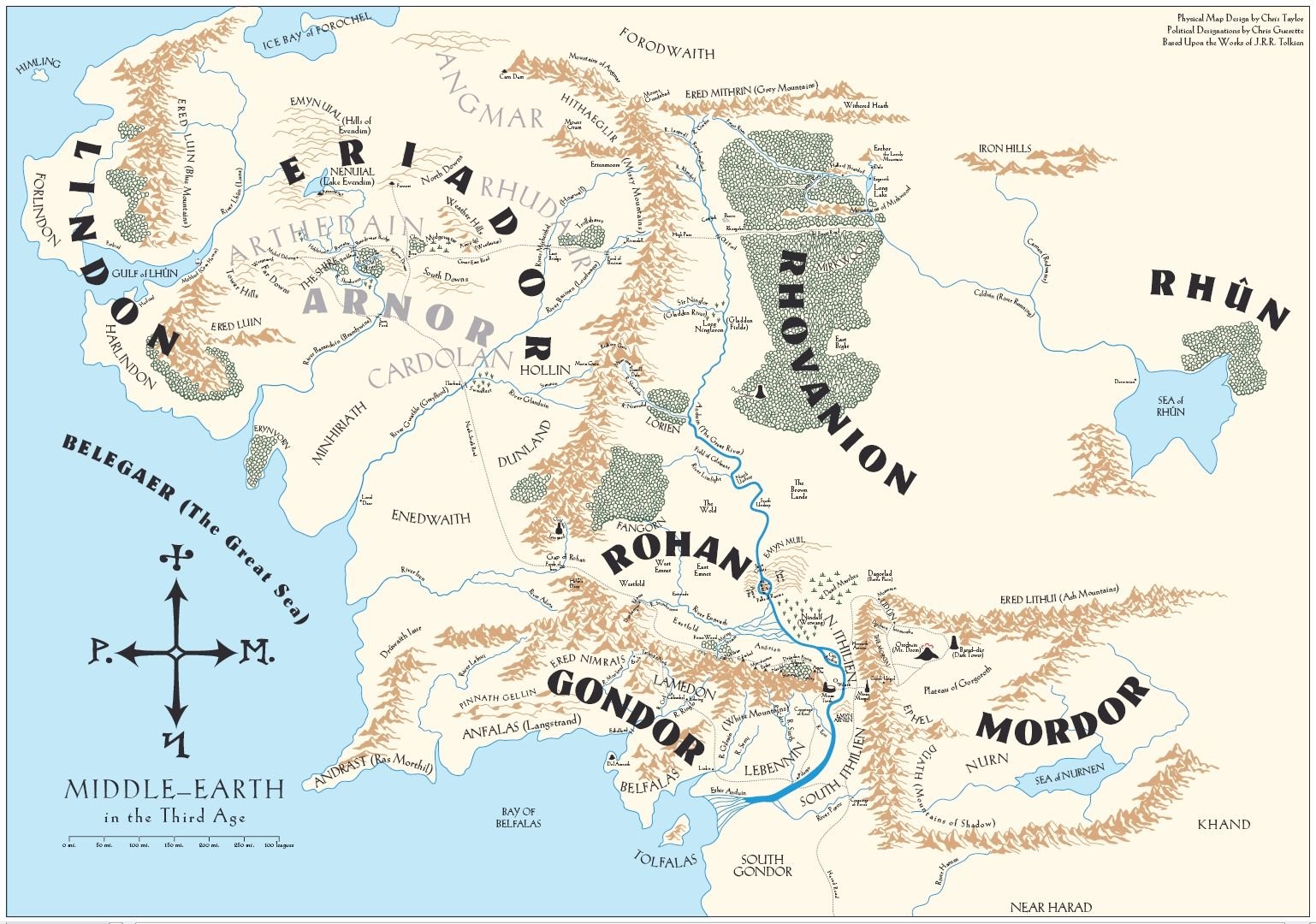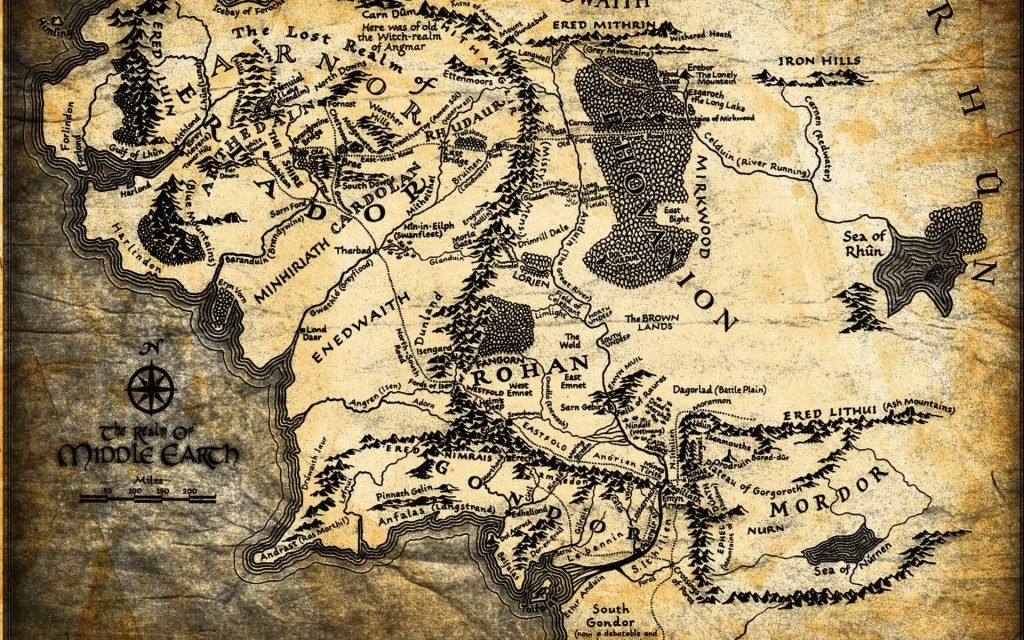Introduction
Map of Middle-earth is a fictional land created by J.R.R. Tolkien. It is the setting for his most famous works, The Hobbit and The Lord of the Rings. Middle-earth is a land of great beauty and danger, and it is home to a wide variety of creatures, both good and evil.
J.R.R. Tolkien was born in South Africa in 1892. He was a professor of English at the University of Oxford, and he was a gifted linguist and scholar. Tolkien was also a lifelong lover of fantasy and mythology, and he drew inspiration from these sources when he created Middle-earth.
Tolkien began writing about Middle-earth in the early 1930s. He worked on his stories for many years, and he eventually published The Hobbit in 1937. The Lord of the Rings was published in three volumes in 1954 and 1955.
Tolkien's works have been translated into many languages and have sold millions of copies. They have also been adapted into several films, video games, and other works of art.
Maps are an important part of Middle-earth. They help to orient the reader and to provide a sense of place. Maps are also used to tell stories. For example, the map of Middle-earth in The Lord of the Rings is used to track the journey of Frodo and his companions.
The Map of Middle-earth

Middle-earth has been meticulously mapped by Tolkien himself and subsequently by artists and cartographers. These maps serve as visual guides, bringing the sprawling land and its myriad locations to life. From the iconic map in "The Hobbit" to the detailed maps found in "The Lord of the Rings," these visual representations offer readers a sense of place and aid in the immersive experience of the stories.
To truly understand the map of Middle-earth, it is essential to grasp the symbols and legends employed. Mountains, rivers, forests, and cities are depicted using specific icons and markings. By familiarizing ourselves with these symbols, we can navigate the map with ease and appreciate the attention to details.
For example, mountains are often represented by triangles, rivers are represented by blue lines, and forests are represented by green areas. The legends on the map provide more information about the features that are represented by the symbols.
Middle-earth is a land of diverse and breathtaking landscapes. From the idyllic and pastoral beauty of the Shire to the dense and mysterious forests of Mirkwood, the map of middle-earth showcases the wide range of environments encountered throughout the stories. Mountains, valleys, plains, and rivers all contribute to the rich tapestry of Middle-earth's geography, shaping the journeys and adventures of its inhabitants.
The landscapes of Middle-earth play an important role in the stories that are set there. For example, the mountains of Mordor provide a natural barrier that protects Sauron's forces from attack.
Middle-earth is divided into various regions, each with its distinct characteristics, cultures, and histories. From the rugged and dangerous realm of Mordor to the majestic realms of Gondor and Rohan, the map of Middle-earth reveals the vastness and diversity of Tolkien's creation. Exploring these regions allows us to appreciate the depth and complexity of Middle-earth's world-building.
The Geography of Middle-earth
Middle-earth, as conceived by J.R.R. Tolkien, has its roots in his broader legendarium known as Arda. Tolkien's mythopoeic vision birthed a richly imagined world with its own cosmology and history. Middle-earth emerged as the central stage for the events chronicled in "The Hobbit" and "The Lord of the Rings."
Middle-earth was created by Eru Ilúvatar, the supreme being in Tolkien's mythology. Eru Ilúvatar created the world in a process called the Music of the Ainur. The Ainur are angelic beings who sang the world into existence. Middle-earth is a flat world surrounded by an ocean. It is located in the northern part of the world, and it is surrounded by several other lands, including Valinor, the Undying Lands, and Harad, the land of the Southrons.
Arda, the world that encompasses Middle-earth, has a round shape, similar to our own planet. However, it is set in a time and place far removed from our reality, with unique features and magical elements that distinguish it from Earth.
Middle-earth boasts a diverse array of landscapes, each with its distinct features and significance. From the towering peaks of the Misty Mountains to the enchanting forests of Lothlórien, the geography of Middle-earth plays a crucial role in shaping the narrative and providing a sense of wonder and adventure.
Mountains, rivers, and seas hold significant importance in Middle-earth. Mountains often serve as natural barriers or strongholds, shaping the course of events and influencing the movements of characters. Rivers provide sources of life and transportation, while seas connect distant lands and harbor both perils and possibilities.
Also Read: 20 Most Ugly Cartoon Characters
Regions of Middle Earth
Middle-earth comprises several distinct regions, each with its own history, inhabitants, and cultural identities. These regions include:
- The Shire: A peaceful and idyllic land inhabited by hobbits, known for its attractive landscapes, cozy hobbit holes, and love of simple pleasures.
- Rivendell: Also known as Imladris, this hidden Elven refuge nestled in the Misty Mountains serves as a shelter and meeting place for various races and is renowned for its beauty and wisdom.
- Mirkwood: A vast and ancient forest covered in darkness and inhabited by mysterious creatures such as the Wood-elves and giant spiders. It is a place of both enchantment and danger.
- Mordor: A barren and bleak land dominated by the dark forces of Sauron. Its volcanic landscape, including the fiery Mount Doom, sets the stage for the climactic events of "The Lord of the Rings."
- Gondor: A kingdom of men known for its magnificence and noble heritage. Gondor stands as a wall against the forces of evil, guarding the lands to the south and preserving the legacy of its ancient kings.
- Rohan: The horse-lords of Rohan dwell on the vast grassy plains and are renowned for their horsemanship and bravery. Their alliance with Gondor plays a pivotal role in the defense of Middle-earth.
- The Misty Mountains: A terrifying mountain range spanning Middle-earth, hiding deep tunnels, treacherous passes, and the hidden kingdom of the dwarves.
- Erebor: The Lonely Mountain, once home to the dwarves and the fabled kingdom of Erebor, known for its vast wealth and the mighty dragon Smaug.
- The Grey Havens: A haven for elves, located on Middle-earth's western shores. It serves as a departure point for those seeking passage to the Undying Lands.
These regions, among others, form the tapestry of Middle-earth, each with its unique geography and significance to the story.
The History of Middle-earth
The First Age

The history of Middle-earth begins with the loud events of the First Age, a time of epic battles, great heroes, and the rise and fall of kingdoms. This Age was the age of the Elves. It was a time of great conflict between the Elves and Morgoth, the first Dark Lord. Morgoth was a powerful Maia who rebelled against Eru Ilúvatar. He created a great evil called the One Ring, and he used it to enslave the Elves.
The Elves eventually defeated Morgoth, but at a great cost. The First Age ended with the destruction of the One Ring, and the Elves were forced to leave Middle-earth for Valinor, the Undying Lands.
The Second Age

The Second Age was the age of the Men. It was a time of great prosperity for the human kingdoms of Númenor and Gondor. Númenor was a powerful island kingdom that was founded by the Men who were granted immortality by Eru Ilúvatar. Gondor was a human kingdom that was founded by the descendants of Númenor.
The Second Age ended with the destruction of Númenor by Eru Ilúvatar. Númenor was destroyed because its people had become too proud and had tried to challenge Eru Ilúvatar. The destruction of Númenor was a great tragedy for the Men of Middle-earth, and it left them vulnerable to the forces of evil.
The Third Age

"The Hobbit" and "The Lord of the Rings" take place during the Third Age. It is a time of great danger, as Sauron, the Dark Lord, seeks to conquer Middle-earth. Sauron is a powerful Maia who was defeated in the First Age. He has been rebuilding his strength in the Third Age, and he is now ready to challenge the Free Peoples of Middle-earth.
The Third Age is also the time of the War of the Ring. The War of the Ring is a great conflict between the forces of good and evil. The fate of Middle-earth hangs in the balance, and the outcome of the war will determine whether Middle-earth will be ruled by Sauron or by the Free Peoples.
The Fourth Age
The Fourth Age marks the beginning of a new era, following the defeat of Sauron. It is a time of rebuilding, healing, and the passing of the age of elves and great powers, as the dominion of men takes fame in Middle-earth.
Major Events in Middle-earth
Throughout its history, significant events shape Middle-earth, such as the Battle of Dagorlad, the Last Alliance of Elves and Men. These pivotal moments leave lasting impacts on the land and its inhabitants.
The People and Creatures of Middle-earth
Middle-earth is homemptation of power and the downfall of Númenor, leading to the reshaping of the world to a multitude of races, each with its own unique characteristics and contributions to the world. These races include:
- Humans: The race of men, represented by various kingdoms and cultures such as Gondor, Rohan, and the people of Dale. Humans play a crucial role in the struggle against evil and the preservation of Middle-earth.
- Elves: Immortal and graceful, the elves are one of the oldest races in Middle-earth. Known for their wisdom, craftsmanship, and connection to nature, they reside in realms like Rivendell, Lothlórien, and the Grey Havens.
- Dwarves: Skilled craftsmen and miners, the dwarves are renowned for their love of treasures and their mighty underground cities, such as Erebor and the mines of Moria.
- Hobbits: Small in stature but big in heart, hobbits are a peaceful and unassuming race known for their love of food, comfort, and simple pleasures. The Shire is their homeland, and their unassuming heroism plays a vital role in the quest to destroy the One Ring.
- Orcs: A dark and twisted race bred by evil, orcs serve as the foot soldiers of Sauron and other dark forces. They are fierce and brutal warriors, embodying the destructive nature of their masters.
- Ents: Ancient tree-like beings entrusted with the protection of forests and natural wonders. Ents, such as Treebeard, possess great wisdom and power, symbolizing the symbiotic relationship between nature and the inhabitants of Middle-earth.
Languages of Middle-earth
Tolkien's meticulous world-building extends to languages, with various races having their distinct tongues. Elvish languages, such as Quenya and Sindarin, showcase their beauty and complexity. The Dwarves have their own secret language, while the common speech of men and the hobbits is in Westron. The creation of these languages adds depth and authenticity to the diverse cultures and peoples of Middle-earth.
Creatures of Middle-earth
Middle-earth is full of mythical creatures, both kind-hearted and evil-minded. From the noble and majestic eagles to the treacherous and cunning dragons, the creatures of Middle-earth play essential roles in the narratives. Other notable creatures include the Balrogs, giant spiders, wargs, and the mysterious and mischievous Tom Bombadil.
Culture of Middle-earth
Each race in Middle-earth possesses its unique culture, customs, and ways of life. Whether it's the hobbits' love of good food and comfort or the elves' appreciation for art and nature, these cultural elements shape the interactions and dynamics among the inhabitants of Middle-earth.
Kingdoms in Middle-earth
Gondor, ruled by the supervision of the line of Isildur, stands as a support of human strength and resilience. Rohan, led by the horse-lords and their kings, boasts a proud warrior tradition. The dwarf kingdom of Erebor and the Elven realms of Rivendell and Lothlórien are just a few examples of the rich shades of kingdoms in Middle-earth.
The Significance of Middle-earth
The enduring legacy of J.R.R. Tolkien's Middle-earth is undeniable. His cautious universe, rich characters, and masterful storytelling have left an indelible mark on the literary landscape. Tolkien's work continues to inspire countless authors, artists, and creators, and his contributions to the fantasy genre are unparalleled.
Middle-earth has filled popular culture in profound ways. From movies and TV shows to video games and merchandise, Middle-earth's influence spread in a wide array of mediums. The success of Peter Jackson's film adaptations brought Middle-earth to the masses, captivating audiences with their stunning visuals and epic storytelling. The films not only introduced a new generation to Tolkien's world but also solidified Middle-earth as a cultural phenomenon, inspiring a wave of adaptations and spin-offs.
Tolkien's Middle-earth is more than just a backdrop for fantasy adventures. It is a rich tapestry of themes and patterns that explore profound aspects of the human condition. From the corrupting nature of power and the consequences of greed to the triumph of hope and the enduring strength of unity, Middle-earth's tales resonate on a deeper level, offering timeless lessons and insights into the human experience.
Embedded within the narratives of Middle-earth are powerful themes that speak to universal truths. The struggle between good and evil, the value of friendship and loyalty, the importance of courage and sacrifice, and the quest for self-discovery and personal growth are just a few of the resonating themes that make Middle-earth more than just a fictional world. These themes have the power to inspire and provoke introspection, leaving a lasting impact on readers.
Exploring Middle-earth
For those eager to embark on their own Middle-earth adventure, there are various ways to immerse oneself in Tolkien's world. Reading the novels is a must, as they provide the most comprehensive and detailed experience of Middle-earth. Supplement your reading with beautifully illustrated editions to enhance the visual aspect. Additionally, exploring interactive adaptations, such as video games and online experiences, can offer a unique and immersive way to engage with Middle-earth.
The film adaptations of "The Lord of the Rings" and "The Hobbit" by Peter Jackson brought Middle-earth to life on the big screen in a spectacular fashion. Watching these films allows audiences to visually experience the landscapes, characters, and epic battles of Tolkien's creation. Consider organizing a movie marathon to fully immerse yourself in the cinematic wonders of Middle-earth.
Middle-earth merchandise offers fans the opportunity to bring a piece of the realm into their own lives. Collectible models, clothing, maps, and replica props allow enthusiasts to display their love for Middle-earth in tangible ways. Explore online stores, visit specialized shops, or attend conventions to discover a wide range of merchandise options.
In the near future, Middle-earth theme parks will provide fans with an unparalleled opportunity to step into the land themselves. These immersive experiences promise to transport visitors to iconic locations, allowing them to walk in the footsteps of their favorite characters and truly live out their Middle-earth dreams.
FAQs
[faq-schema id="8251"]
Conclusion
Middle-earth, with its detailed map, rich history, diverse inhabitants, and enduring themes, continues to capture the imagination of readers and fans worldwide. Whether through the pages of Tolkien's novels, the visual splendor of the films, or the interactive experiences available, exploring Middle-earth offers a journey of wonder, inspiration, and timeless lessons. So, grab your map, start your own adventure, and immerse yourself in the enchanting lands of Middle-earth.



